Angula, the treasure of dark nights
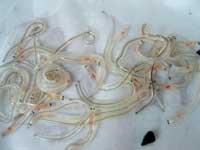
Last year the angula was captured little. In addition, at the time of the Basque Country, fuel stains spilled by the oil tanker Prestige arrived on the coast and people feared that the fuel would damage the angle. Fortunately, the one who entered the basins was healthy. Condemnation.
As in other catches, it was questioned whether the angles met the quality parameters of the market. As a result, this year's angular season was delayed. Although it was legally going to start on October 15, until a month later angler fishing was not authorized.
Medical examination of angles
During this month, the collection of hydrocarbons from the discharge of fuel by the angles was studied. And having no indication of the most stable hydrocarbons, the beginning of the angular season was authorized. Since then, the quality of the angles is analyzed monthly at the Azti Foundation.
The first step in conducting the health study of the angles is sampling, which researchers receive with the help of anglers. They go fishing on the nights near the cemetery. They operate in river basins with the greatest tradition of angler fishing in Bizkaia and Gipuzkoa. And a portion of the catch, about 20 grams, is taken to the lab, provided the catch has given enough.
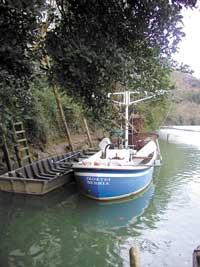
In the laboratory, once measured, heavy and lyophilized, they use gas chromatograph for extraction. They introduce the extract into the mass spectrometer and analyze the presence of hydrocarbons in the sample. Through mass spectrometry, they are able to detect twenty-four polycyclic aromatic hydrocarbons (PAHs), including the most important discharges by the Prestige.
Unfortunately there is no clear criterion for relating the maximum PAH concentration to the angle consumption. The Spanish Food Safety Agency takes into account the sum of the concentrations of six PAHs when deciding whether fish is suitable for consumption, while that of France takes into account the sum of ten more. Both values are calculated in Azti.
A time of anguish full of innovation
The corner season has had more news. The licensing system has been implemented for the first time and this traditional fishing has its own law (Decree 41/2003 of 18 February on angling). Thus, the angler fishing has gradually been equated with the rest of the fishing systems.
Licenses aim to investigate the state of the angles. To do this, graduates fill in a sheet of catches. This sheet lists the catch made by each angler, the diameter of the bayet used and the acting time, as well as whether he has worked from land or by motor boat. All this allows to know the number of angles that enter the rivers.
The researchers combine these data with those they have collected themselves and thus make a count. An approximate calculation calculates the abundance index. This index is the unit used for the rest of calculations and comparison.
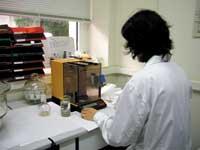
In this sense, it is estimated that in the short term the stock of eel will be determined, that is, the amount of angula and eel that can be fished so as not to endanger the population of eel.
Since this data collection has not been carried out so far, no comparative data is available, so it will be difficult to obtain conclusions in the short term, but in the long term the evolution of the angle population will be followed.
However, the concern for the angle is not exclusive to Euskal Herria. The European Union wants to promote research on angula and eel. Under this decision is the significant decrease in the eel population. Since there is no exhaustive knowledge of the life of this fish, it is difficult to cope with the population decline, so it is necessary to strengthen research. The European eel (Anguilla anguilla) has been included in the list of fish of special relevance. As a result, all EU countries are required to supply data on research catch.
Worsening of habitats
Researchers do not know with certainty what has caused the decrease of the angle and, inevitably, of the eel. Surely there is not a single reason, but a whole. Among other things, keep in mind that the eel is a fish that lives a long time and therefore, in cases where it lives in contaminated waters, accumulates pollutants in the body for many years. Therefore, it is considered that river pollution is one of the causes of the decline of the eel population, even indirectly.
In fact, the eel can live in very polluted waters; so to speak, it does not look too much at the chemical quality of the water when choosing its residence. Therefore, it is difficult to assess the impact of pollutants on the eel population. Pollution can affect reproduction, but scientists do not have data to support it.
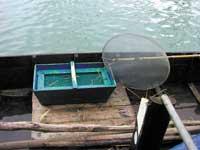
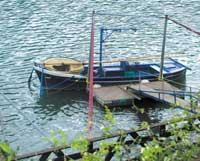
In Belgium, for example, in 2002 eel fishing was banned due to pollutants. It was discovered that it had PCBs and other organochlorine compounds and that it was not suitable for human consumption. However, the eel itself did not seem to be ill.
On the other hand, we only have to look at the river basins to realize that they are completely altered, that they are artificial. Reservoirs, pipes and other works make it difficult to move the eel. It is known that sometimes the eel leaves the water and, going from land through the angula-mangula, reaches lagoons not linked to the river. But to reproduce it has to return to the sea and only has obstacles in the way.
Of course, starting with the reasons for the decline of the eel, one cannot fail to mention fishing. The angled eels or eels never reproduce. Therefore, the life cycle is interrupted. In addition, having such a special life cycle, it cannot be reproduced in nursery. Therefore, even for the breeding of eels it is necessary to capture angles in some river basin.
A perfect excuse to protect rivers
The complexity of the lifecycle is an obstacle to eel recovery efforts, but it also has its advantages. It inhabits all over the Anguilla River and in the sea, so its habitat is very extensive. In the protection programs of this fish must take care of the entire area in which it is located.
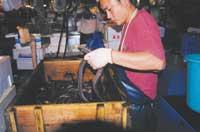
The eel is the perfect excuse to protect aquatic ecosystems. This has been one of the reasons why it has been included in the list of fish species to protect. If you want it to be suitable for human consumption, you have to take care of the chemical composition of water. But not only that, but the key is that the physical structure of rivers must also be preserved. To do this, in addition to maintaining natural channels, we must adapt those that are totally artificial: avoid reservoirs, pipes, etc. that hinder the passage of eels, recover the riparian forests, etc.
There is a lot of work to do. But since the main benefit of this work is the human being himself, as many forces can be achieved as he has united to protect other species. In terms of economic value, the eel is robust, not only when it is angular, and from an ecological point of view it is difficult to find a better excuse to protect aquatic environments. This will improve the situation of all species of these ecosystems, including humans.
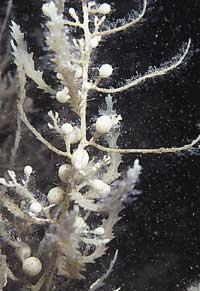
Over the years, fewer angles are being fished. Although the decline began in 1980, it was not noticed until 1993. Researchers do not know what is the main cause. And the reason for so much doubt is simple: the life of the eel is not exactly known.
The eel is born or at least in the Sargasso Sea. The Sargassun Sea is located in the center of the Atlantic Ocean and is named after the seaweed Sargassun vulgare or sargazo that covers the surface of the water. Smaller leptocephalus or eel larvae have been found there, so it is thought to reproduce in the area. Deep laid eggs contain a bag of fat that allows the egg to rise. Upon reaching the surface of the water the leptocephalus is born.
The gulf stream leads the leptocephalus to the northeast. Thus, it reaches Morocco, west of the Mediterranean and the European Atlantic coast. On the continental shelf it metamorphizes: the leaf-shaped leptocephalus adopts the cylindrical appearance of the well-known angle.
This metamorphosis is necessary for the angle to pass from salt water to fresh water. You access the river attracted by the fresh water of the angle accustomed to the salt waters of the sea.
There it starts to pigment the back and loses natural transparency. Gradually ceases to be an angle, which adopts a yellow-green color. Therefore it is called yellow eel. At this time the sex of the eel is defined when it is between three and five years old.
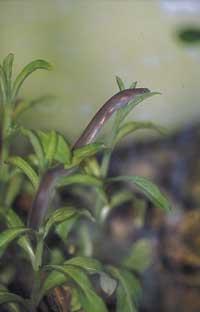
The yellow eel has been in the river for several years: from five to twelve years the males and from seven to sixteen years the females. But it is not able to reproduce. For this, he suffers another metamorphosis: the skin becomes darker and the belly becomes silver. The eel is silver. Reproductive organs develop, eyes grow, and, among other things, the anus closes.
This metamorphosis is called catodrome because, despite living in freshwater, it will proliferate to the sea, so that to adapt to saltwater the body of the eel is transformed.
He leaves the river where he has lived for so many years and goes to the sea. It enters the Atlantic seabed and heads to the Sargasso Sea. He reaches six months, meets the couple and dies after breeding.
Buletina
Bidali zure helbide elektronikoa eta jaso asteroko buletina zure sarrera-ontzian











